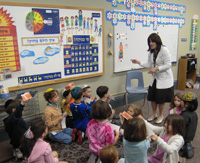By Eric Nusbaum, Assistant Editor, JTNews
While their students enjoyed vacations, the faculty at Seattle Hebrew Academy spent its summer in the classroom — themselves as students. As students began classes this week, the school introduced Hebrew immersion into its Judaic Studies program for the upcoming school year, a major transition for students and teachers alike.
The change will be immediate and simultaneous: Instead of gradually implementing immersion with incoming classes, students at all grade levels at SHA will begin speaking Hebrew for half the day.
“The first month is going to be difficult, but hopefully we will get past that,” said Rivy Kletenik, head of school at SHA. “I think it’s going to be a transition that we are going to rise to.”
A major component of that transition is TaL AM, a popular Hebrew curriculum for 1st through 5th graders already in use locally at the Jewish Day School of Metropolitan Seattle in Bellevue. JDS partnered with SHA to earn a $15,000 opportunity grant from the Samis Foundation. The grant will help offset the costs of educating teachers in TaL AM, fund a mentor to work with the faculty of both schools, as well as one teacher from the Seattle Jewish Community School, where TaL AM is being introduced only for 1st graders.
Nancy Cohen Vardy, who for the past decade has taught at JDS — which has used TaL AM since the curriculum’s inception —will serve in the mentor position. Cohen Vardy will move between the two schools, working to help both new and more experienced TaL Am teachers. In addition to the SHA faculty, which is entirely new to TaL AM, and the SJCS 1st grade teacher, JDS has three new teachers for the 2010-11 school year.
“I am thrilled that she’s doing it,” said Maria Erlitz, JDS’ head of school, of Cohen Vardy. The mentor position was written into the grant with Cohen Vardy specifically in mind. The role gives all three schools a chance to collaborate.
“I don’t think Samis would have funded the grant for just my three teachers,” Erlitz said.
Kletenik, who feels the transition to Hebrew immersion will have an immediate impact on her students’ education, echoed the enthusiasm. To her, the transition is more homecoming than risk, and Hebrew is a crucial part of Jewish culture and education.
“We feel that if we really want there to be success with our students in Hebrew, we’ve got to get to them much earlier,” Kletenik said.
The impetus for moving to Hebrew immersion came from an unlikely source: Kletenik was seated at a conference next to the head of a French-American school, who explained that their students spoke only in French, whether discussing literature or passing a teacher in the hallway.
“She spoke with such great pride in that and I thought, ‘Oh my goodness, what are we doing wrong?’” Kletenik said of the exchange. “We need to be doing so much more in our school because Hebrew is such a vital part of being Jewish.”
And for local Jewish day school students, TaL AM has begun to emerge as a vital part of learning Hebrew. TaL AM was designed to integrate Hebrew with Jewish education for grades 1 through 6, treating Hebrew not as a second language but rather as a vital part of a cultural identity. The Montreal-based organization has regional coordinators assigned to help schools all over the world implement the curriculum.
“I don’t have any knowledge about a better program that exists in the market for day schools,” said Shoshana Bilavsky, the new head of school at SJCS. Bilavsky said she wanted to take the year to evaluate the school’s Hebrew program before deciding to implement TaL AM beyond first grade.
Although SJCS is taking a slower approach to Hebrew immersion, Bilavsky is confident the transition at SHA will be a success. Faculty and parents at SHA share that confidence, said head of school Kletenik.
“I’ve heard only excitement and enthusiasm,” said Kletenik. “We feel that after a year of success we will be able to recruit to this program and be able to say that our students are studying Hebrew.”
And what of the challenges that come with reaching that point and actually getting students to speak Hebrew?
“Hebrew is a miracle,” Kletenik said. “After 2,000 years of it not being actively spoken, it became a spoken language. It is the only case in the history of the world that an ancient language was resurrected.”
